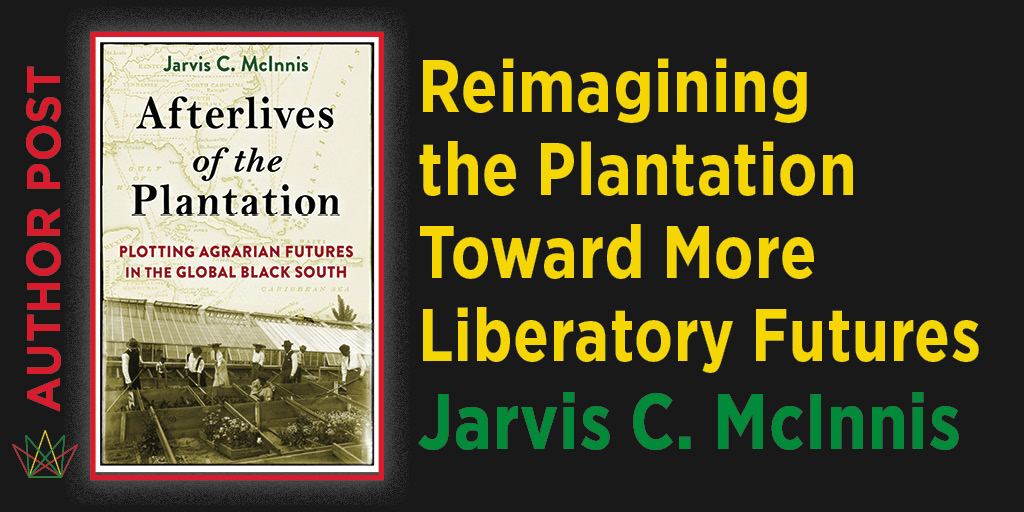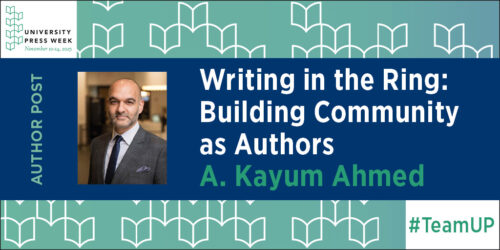Reimagining the Plantation Toward More Liberatory Futures
Strategies in Black Self-Determination
Jarvis C. McInnis

On May 15, 2025, the Nottoway Plantation resort was destroyed by fire. Completed in 1859, Nottoway was a whopping 53,000 square feet with 165 rooms, the largest antebellum mansion in the United States. Of course, such obscene wealth and grandeur depended on the exploitation of 155 Black bondspeople who worked its vast sugar fields. However, the website for the plantation-mansion-turned-forty-room-resort-and-wedding-venue makes no mention of the enslaved. Instead, it lists the names of the sixteen trees on the property, touting the fact that eleven of them were registered with the Live Oak Society of the Louisiana Garden Club Federation, Inc.[i]
In the days and weeks following Nottoway’s burning, debates raged on social media regarding the ethics of preserving such historical sites. Many commenters gleefully celebrated Nottoway’s burning, likening the estate to a concentration camp and regarding its uncritical preservation and erasure of Black suffering as a metaphor for how the United States routinely negates the crimes of its settler-colonial and slaveholding past and the ways they continue to shape present conditions, especially for African Americans. Others viewed it as a loss to American and, for some, African American history since the 155 people once enslaved on Nottoway would have performed much of the backbreaking labor to construct the palatial structure and plantations often hold important archival and archaeological data about the slave past.
As we commemorate Juneteenth and celebrate the occasion of enslaved peoples finally receiving the glad tidings of freedom and slavery’s abolition, the debate over Nottoway recalls the unfinished work of emancipation in this country. It points to the persistence of the plantation not only as a material presence on the landscape but also as an ideological stronghold that continues to impede the country’s ability to live up to its ideals of liberty and justice for all.
The debate over Nottoway recalls the unfinished work of emancipation in this country.
In my new book, Afterlives of the Plantation: Plotting Agrarian Futures in the Global Black South, I tell a different and underexplored story of the plantation that focuses on Black resilience, ingenuity, and self-determination. Instead of the whitewashing and revisionism that places like Nottoway and the broader plantation-tourism and wedding industries perpetuate, Afterlives of the Plantation examines how formerly enslaved peoples and their descendants throughout the Global Black South—including the U.S. South, the Caribbean, and Latin America—attempted to transform and repurpose plantation geographies and their accompanying logics into independent farms and colonies, schools, cooperatives, and other modes of uplifting the race as they confronted the new challenges of freedom, colonial subjecthood, and often quasi citizenship that awaited them in slavery’s aftermath.
Take for example Mitchellville, South Carolina, also known as the Port Royal Experiment. Before the Civil War, there were more than twenty plantations in operation on Hilton Head Island, South Carolina. In 1862, as the war raged, Major General Ormsby Mitchel of the Union Army “saw the living conditions of the formerly enslaved ‘contraband’ in the refugee barracks” and “directed a new ‘negro village’ near Drayton Plantation to be built by and for the freedm[e]n/refugees, complete with homes, police protection, and a school.” Indeed, the town instituted “the first compulsory education law in South Carolina, requiring education for every child from the ages of 6-15 years of age.” After the Union withdrew from the South, the Drayton Plantation, where Mitchelville was established, was eventually returned to the heirs of its original owners; however, they had no interest in resuming the plantation and sold it off to various buyers, many of whom were freedpeople. Toward the end of the nineteenth century, most of the land that made up Mitchelville was sold to March Gardner, a freedman.[ii]
While some of these experiments in repurposing the plantation toward more liberatory ends were successful, like Mitchelville (at least initially), others were less so. Immediately after the war, Benjamin Thornton Montgomery, father of Isaiah Montgomery, founder of the all-Black town of Mound Bayou, Mississippi, attempted to transform the plantation where he had been enslaved into an all-Black community. The elder Montgomery had been enslaved by Joseph Davis, the brother of Jefferson Davis, president of the Confederacy. After the war, Joseph sought to keep his formerly enslaved property together and gradually usher them into freedom, believing “there should be just as little break in the old relations as possible” with the exception that “the freedmen should, however, eventually become the owners of the land upon which they had previously been slaves.” Ultimately, Benjamin found the conditions untenable, because they adhered too closely to those of slavery. Without “a modification of the terms,” he determined it was “impossible to succeed” and eventually abandoned the scheme altogether. Herein lies the failure of the repurposed plantation, wherein the “old relations” constrained Black life even in freedom. When Isaiah Montgomery established Mound Bayou a few years later, he did so on thoroughly “wild” and uncultivated land, where the “old relations” had never taken root.[iii]
While some of these experiments in repurposing the plantation toward more liberatory ends were successful,…, others were less so.
This practice of repurposing plantation lands was an important strategy of Black self-determination outside of the United States as well. After emancipation in the British West Indies, for instance, freedpeople in Guyana and Jamaica engaged in what Eleanor Marie Brown calls “the freed village movement,” wherein they pooled resources to acquire defunct plantations and subdivided the land into smaller tracts. “Within four years of Emancipation,” Brown maintains, “nearly 15 percent of the formerly enslaved population [of Jamaica] were independent farm owners on abandoned estates.” Some freedpeople in the British West Indies established cooperatives, wherein they grew provisions for internal consumption, and others became independent farmers, attempting to grow sugar and cotton for the global market.[iv] Haiti’s counter-plantation system, wherein formerly enslaved peoples and their descendants pursued an alternative, collective land tenure system that challenged the individualistic and proprietorial logics of the plantation, is another important example of this practice in the Americas.
In addition to establishing independent farms, communities, and towns, formerly enslaved peoples and their allies transformed plantations into educational institutions. Throughout the United States, numerous historically Black colleges and universities (HBCUs) were founded on the grounds of former plantation estates, including Prairie View A&M University, Florida A&M University, and my alma mater, Tougaloo College. And although the University of the West Indies, Mona campus, is not technically an HBCU (as we conceive them in the United States), it too was established on two adjoining former sugar estates, further indicating the ways this praxis of reterritorialization—of reinvesting the plantation with new meanings—was an important strategy across the hemisphere.
In Afterlives of the Plantation, I focus on the ways Booker T. Washington, the African American educator, orator, and political leader, transformed Colonel William Banks Bowen’s former cotton plantation where the big house had been burned during the Civil War and the soil was depleted due to abusive, large-scale monocrop agriculture, into a world-renowned school: Tuskegee Institute (now University). In his autobiography, Up from Slavery, Washington noted that since the “big house” had been burned during the Civil War, it was “just the location that we wanted in order to make our work effective and permanent,” no doubt hoping that the racial-capitalist logics of plantation slavery had been razed along with it.[ii] Through Tuskegee, Washington and the school’s faculty and staff—including his third wife, Margaret Murray Washington, a leader of the Black women’s club movement, and the celebrated agricultural scientist, George Washington Carver—established a world-renowned institution that foregrounded agricultural and industrial education as a strategy for Black progress and futurity. Through print culture, photographs, music, and its students, Tuskegee’s curriculum circulated throughout the former plantation regions of the Americas, including Cuba, Puerto Rico, Haiti, Jamaica, and Guyana. These places, too, were wrestling with the aftermath of the slavery, where the plantation still had a stranglehold on Black futures, and Tuskegee’s strategies of self-determination through agricultural and industrial education appealed to them as a viable model for their own futures.
This practice of repurposing plantation lands was an important strategy of Black self-determination outside of the United States as well.
Although the big house that once occupied the Bowen plantation was burned, Tuskegee continued to wrestle with the plantation—materially, ideologically, and sociopolitically—well into the twentieth century. In fact, because of Washington’s conservative, accommodationist political stances, Tuskegee is often conflated with the plantation in much of Black Studies scholarship and the popular imagination. In Afterlives of the Plantation, however, I draw out the affordances of Tuskegee’s vision of agrarian world making to demonstrate its contributions to Black modernity and Black Studies. Through George Washington Carver’s soil-regeneration experiments, for example, Tuskegee sought to teach poor Black farmers how to steward the land in ways that were sustainable and profitable and counteracted the racial and ecological exploitation of the postslavery plantation system. Through Washington’s oratory and the school’s vast print culture, these ideas circulated to leading figures throughout the Global Black South, such as the Cuban journalist and statesman Rafael Serra y Montalvo and the Haitian statesman, medical doctor, and scholar Jean Price-Mars, both of whom adapted and incorporated aspects of the Tuskegee project into their visions of Cuban and Haitian modernity, respectively.
Furthermore, since Tuskegee was primarily a school, the ideas generated there, as well as what it came to symbolize—a modern Black self-governing institution—inspired generations of students and intellectuals throughout the Black world, including several luminaries of the Harlem Renaissance and the New Negro Movement of the 1920s and 1930s, such as Zora Neale Hurston, Claude McKay, and Marcus Garvey. In Afterlives of the Plantation, I show how each of these figures continued to wrestle not only with Washington and Tuskegee but also with the material, ideological, and aesthetic legacies of the plantation in their life and work: in McKay’s poetry and fiction; Hurston’s music, dance, theater, and anthropological studies; and Garvey’s vision of pan-African, agro-industrial, economic cooperation. In short, Afterlives of the Plantation tells the story of how global Black southerners strained against the plantation’s ongoing assault on Black life by attempting to uproot a structure that essentially gave rise to Western, racial-capitalist modernity and transform it toward more liberatory ends.
In the days after the burning of Nottoway, the owner, attorney William Daniel Dyess, expressed his desire to rebuild the mammoth structure:
“I take this position—we are non-racist people. I am a lawyer and my wife is a judge. We believe in equal opportunity rights for everyone, total equality and fairness,” Dyess said. “My wife and I had nothing to do with slavery but we recognize the wrongness of it.
“We are trying to make this a better place,” he added. “We don’t have any interest in left wing radical stuff. We need to move forward on a positive note here and we are not going to dwell on past racial injustice.”[v]
In light of Dyess’s egregious tone deafness, Juneteenth calls on us not to “dwell” but to remember, bear witness for, and commemorate the enslaved peoples that Nottoway and other plantation tourist sites continue to erase, silence, and reduce to “left wing radical stuff” and “past racial injustice.” As I demonstrate in Afterlives of the Plantation, there are viable alternatives that Dyess and other owners of similar historical sites can pursue that do not perpetuate the plantation’s history of racial-sexual and ecological violence and erasure. But they require a willingness to listen, repair, and reimagine in ways that Nottoway’s new owners have no interest in doing—not yet anyway.
So in a political moment where the gains of the Civil Rights Movement and the alleged racial reckoning of 2020 are being strategically dismantled at every turn; where racial and sexual minorities, women, and immigrants are being met with increased bigotry, misogyny, homo-, trans- and xenophobia; and where affirmative action and reproductive rights and freedoms have been struck down and immigrants and refugees are being rounded up and deported in the most callous and inhumane ways, perhaps the burning of Nottoway Plantation is a small act of poetic and cosmic justice—reminding us that, just maybe, the arc of history bends toward justice after all.
Jarvis C. McInnis is an Associate Professor of English at Duke University and the author of Afterlives of the Plantation: Plotting Agrarian Futures in the Global Black South.
[i] https://www.nottoway.com/history.
[ii] https://exploremitchelville.org/our-story/.
[iii] Booker T. Washington, “A Town Owned by Negroes” The World’s Work Vol. XIV, No. 3 (July 1907): 9131, 9126.
[iv] Brown, Eleanor Marie, On the Evolution of Property Ownership Among Former Slaves, Newly Freedmen (June 23, 2016). GWU Legal Studies Research Paper No. 2016-22; GWU Law School Public Law Research Paper No. 2016-22. Available at SSRN: http://ssrn.com/abstract=2799648
[v] Booker T. Washington, Up From Slavery (1901). Ed. Louis R. Harlan. New York: Penguin, 1986. 128-29.
[i] Dana Kennedy, “Owner of largest antebellum mansion in the South hopes to rebuild after devastating fire — as some celebrate its destruction,” https://nypost.com/2025/05/17/us-news/owner-of-ruined-nottoway-plantation-in-la-hopes-to-rebuild/.
Categories:African American / Black StudiesAmerican HistoryAuthor-Editor Post/Op-EdBlack History MonthBlack StudiesHistoryLiterary Studies
Tags:Afterlives of the PlantationBlack FuturesBlack Lives in the Diaspora: Past Present FutureBlack Self-DeterminationCommunity EmpowermentJarvis C. McInnisJuneteenthJuneteenth 2025Nottoway Plantation resortPlantationPlantation HistoryRacial Justice








